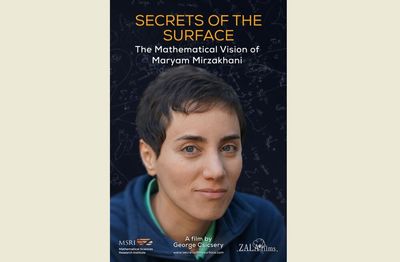Critic Manuchehr Akbarlu will attend the review session, which will be held following a screeninf of ''Secrets of the Surface: The Mathematical Vision of maryam Mirzakhani'' at 5 pm.
Filmed in Canada, Iran and the United States, the documentary examines the life and mathematical work of Mirzakhani, an Iranian immigrant to the United States who became a superstar in her field.
In 2014, she was both the first woman and the first Iranian to be honored by mathematics' highest prize, the Fields Medal.
Mirzakhani's contributionsl are explained by leading mathematicians and illustrated by animated sequences.
Her mathematical colleagues from around the world, as well as former teachers, classmates and students in Iran today, convey the profound imact of her achievements.
The path of her education, success on Iran's Math Olympiad team and her brilliant work, make Mirzakhani an ideal role model for girls looking toward carreers in science and mathematics.
Born in 1977, Mirzakhani grew up in Tehran. She attended Tehran Farzanegan School, part of the National Organization for Development of Exceptional Talents (NODET).
In 1994, Mirzakhani earned a gold medal at the Internaional Mathematical Olympiad (IMO), the first female Iranian student to do so.
In the 1995 IMO, she became the first Iranian student to achieve a perfect score and to win two gold medals. She obtained her BSc in mathematics in 1999 from the Sharif University of Technology.
She then went to the United States for graduate work, earning her Ph.D. in 2004 from Harvard University, where she worked under the supervision of Fields medalist Curtis T. McMullen.
At Harvard, she is said to have been ''distinguished by ... determination and relentless questioning,'' despite not being a native English speaker, and took her class notes in Persian.
Mirzakhani was a 2004 research fellow of the Clay Mathematics Institute and a professor at Princeton University. In 2008 she became a professor at Stanford University.
Her research topics included Teichmuller theory, hyperbolic geometry, ergodic theory and symplectic geometry. Mirzakhani made seceral contributions to the theory of moduli space of Riemann surfaaces. In her early work, she discovered a formula for expressing the volume of moduli space of surfaces of type (g,n) with given boundary lengths as a polynomial in those lenghts.
This led her to obtain a new proof for the formula discovered by Edward Witten and Maxim Kontsevich on the intersection numbers of stable classes on moduli space of curves, as well as an asymptotic formula for the growth of the number of simple closed geodesics on a comapact hyperbolic surface, generalizing the theorem of the three geodesics for spherical surfaces, which states that evrey Riemannian manifold with the topology of a sphere has at least three simple closed geodesics.
In 2014, with Alex Eskin and with input from Amir Mohammadi, Mirzakhani proved that complex geodesics and their closures in moduli space are surprisingly regular, rather than irregular or fractal. The International Mathematical Union said in its press release, ''it is astounding to find that the rigidity in homogeneous spaces has an echo in the inhomogeneous world of moduli space.''
In 2014, she became both the first woman and the first Iranian to be honored with the Fields Medal. The award committee cited her work in ''the dynamics and geometry of Riemann surfaces and their moduli spaces.''
Mirzakhani was married to Jan Vondrák, a Czech mathematician and eventual colleague. They had one child. Mirzakhani died of breast cancer in 2017 at the age of 40.
Source:Tehran Times

